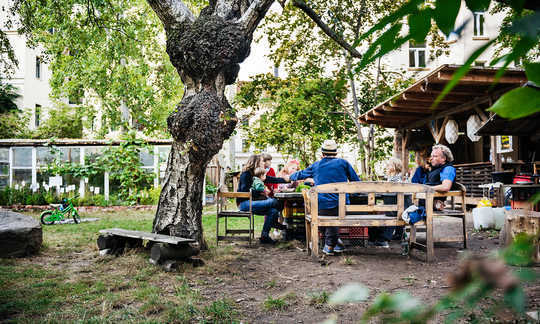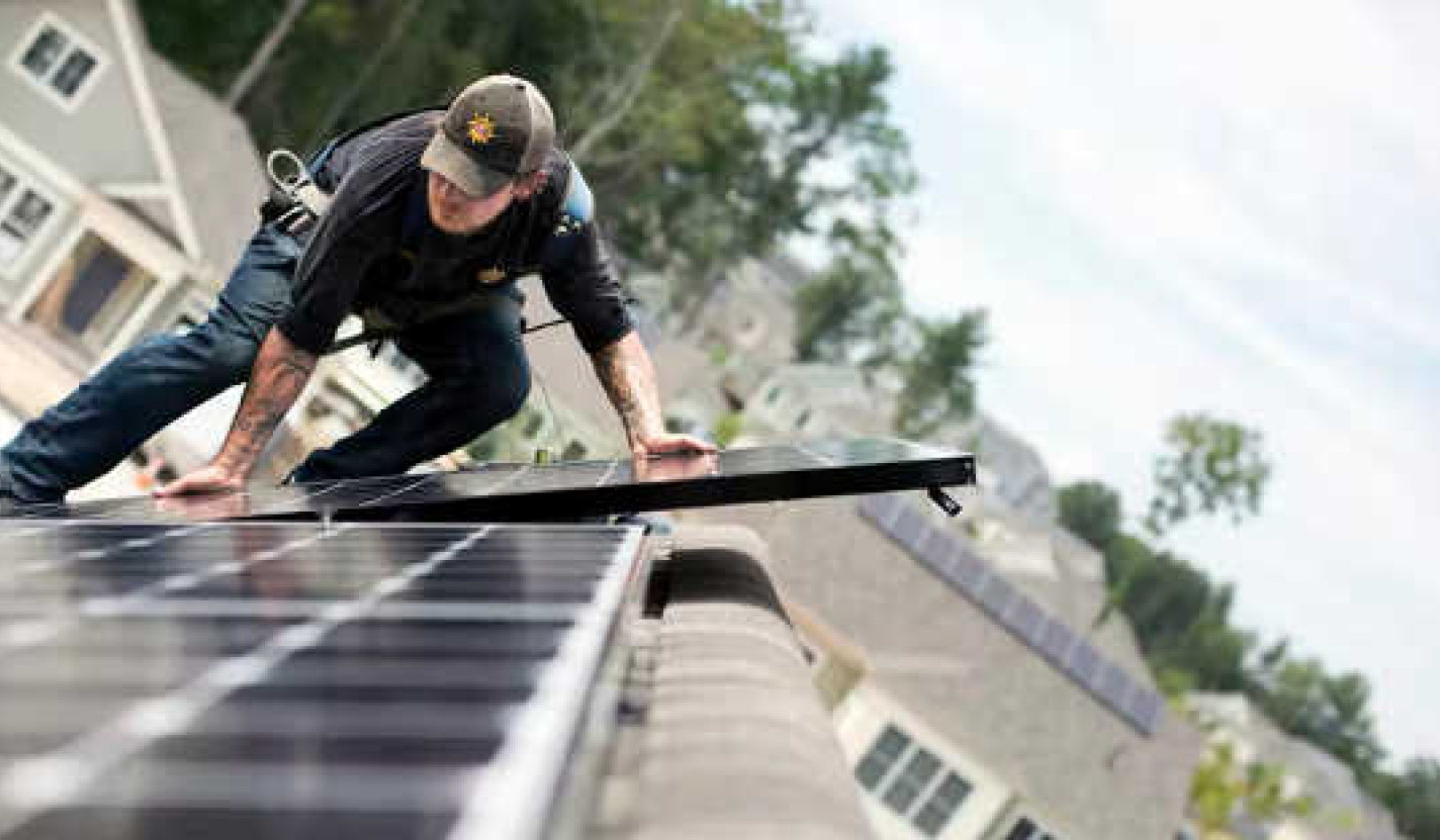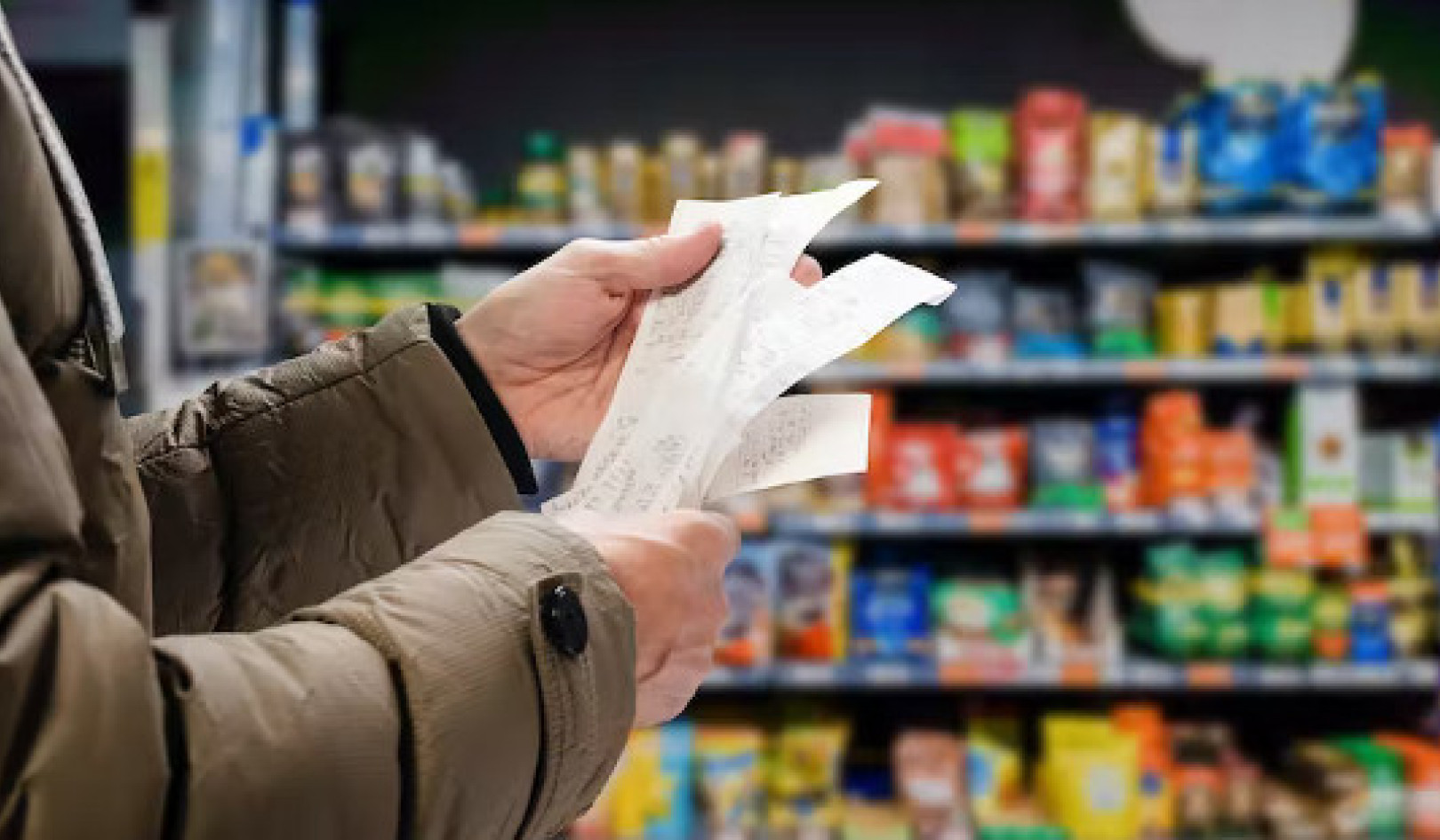
A walk into the future, in a British city where housing is sustainable, energy is locally owned, food is abundant, and the work week is just three days long.
I wake, well rested, in the straw-bale-walled apartment my family and I call home. Built 15 years ago as part of a sustainable-construction initiative throughout our city, the three-story-high apartment complex costs virtually nothing to heat, its basement hosts composting units for all the building’s toilets, and the solar panels on the roof generate all our electricity needs. I wake my kids, get them dressed and fed and accompany them to school—a walk that takes us through shared gardens with a diversity of food crops, including young ruby chard whose deep red leaves radiate like stained glass caught in the brilliant sun of this late spring morning. The streets are quiet, due to sparse motorized traffic, and they are lined with fruit and nut trees in early blossom. The air smells of spring. Each bus stop we pass is surrounded by a garden on three sides, part of the Edible Bus Stop network that now includes most bus stops across the United Kingdom. Anyone can graze while they wait for the bus.
In our community, the kids seem to have radically different feelings about school than they did 10 years ago. The education department’s decision to eliminate testing, to give ample space for unstructured play and to provide students with opportunities within the community to acquire meaningful skills that enable them to live happy and healthy lives by their own definition means that most kids here now love going to school. My son, for example, recently upped his cooking skills by spending a week at a local restaurant.
My kids and I approach the school through intensive food gardens, planted and managed by the students, and walk into a building where we are greeted by the smell of baking bread and the sound of happy chatter. After we say our goodbyes, I pick up a public bicycle and head into the city on one of our cycle networks. With more bicycles and fewer cars on the road, air quality has improved, and public health along with it. I call into my favorite bakery to buy bread. Launched 15 years ago on the premise that “baking is the new Prozac,” the bakery’s mission is to provide meaningful work opportunities for people who lack housing and job security, and who struggle with mental health (1.) The bakery prioritizes local produce, grows a thriving rooftop garden and uses bicycle-powered delivery around town (2.) With the bakery’s support, many of its employees have launched other successful businesses across the city.
I pass what used to be one of the district’s supermarkets, most of which closed down about 10 years ago. The explosion in community food production and rapid shift of community investment led to a withdrawal of support from supermarkets, which precipitated the collapse of the industrial food model over the space of only a couple of years. The building was repurposed and became home to a variety of local food processors, small-scale manufacturing, and a training center linked to local schools. The place is buzzing. Our former supermarket houses a mill that processes locally grown grains, as well as a sawmill that processes locally harvested timber. What had been extensive car parks are now intensive food gardens—modeled on those that surrounded Paris a hundred years ago—and they provide local food for local markets.
I stop by the train station to buy tickets for a trip the following week. Bringing the trains into public ownership 12 years ago eliminated the days when every train station looked the same, with the same cafes, chains and shops. Now every station is a manifestation of the local economy—its innovators, its unique flavors and tastes. Ours now has twice the number of outlets as before, and it reflects the cultural diversity of our community. There is even a brewery at the station. You can have a drink, surrounded by the fermenters, while you wait for your train (3.) Oh, and the trains now run on time. The many people from other places who arrived here during the times of great migration have assimilated, and now it’s hard to remember this community without them. While that transition wasn’t without its challenges, the culture, the richness, the enterprise they have brought have much enriched us all.
I arrive at work. I’m working a half day today, as part of my three-day workweek. Adopted nationally 10 years ago, the three-day workweek, together with the introduction of Universal Basic Income, has resulted in measurably lower levels of anxiety and stress across all income classes. People spend free time working on community projects and enjoying their lives. Some of my colleagues are away today. A scheme was recently launched where up to 10 percent of staff from any company, at any given time, are embedded in the local community, offering managerial, marketing, financial planning and project management skills to organizations that are working in various ways to support residents and make our community more resilient.
I pick up my kids from school and we stroll home down streets where many of the houses are painted with eye-catching murals and mosaics. There are lots of kids playing in the street, a phenomenon that occurred naturally once the number of cars on the road diminished, which in turn encouraged residents to periodically close their streets entirely to motorized traffic, so children can play outside; all the neighbors look out for the kids, something made possible when adults began spending more time at home, rather than trapped in long commutes to distant workplaces.
After supper, I head out to a Neighborhood Assembly meeting. A few years ago, a group of residents, not aligned to any political party, were voted in to run our city government. They altered the city’s governance model to enable and support the initiatives emerging at the neighborhood scale, and to remove obstacles. They even created a Civic Imagination Office to better inspire and support the imaginations of local communities, and to enable their ideas to become reality. About 70 people are at this particular meeting, and we discuss our vision for the future of energy in our neighborhood, and some other pressing local issues. Policymaking has improved hugely. Thanks to the community-owned energy company set up in 2021, the majority of the city’s energy is now locally generated, and most citizens have some kind of financial investment in it; it generates a far better return than the banks do.
When I reach home, I visit with several of my neighbors, who are sitting outside chatting. We hear an owl, and notice the bats swooping overhead. The move to designate our city a National Park City slowed the decline of biodiversity to the point of recovery by reunifying previously fractured wildlife corridors, green spaces, and woods, so that I now regularly notice new kinds of insects and louder and more complex birdsong. With so much around me moving, changing and thriving, I settle down to sleep with a feeling that the future is rich with possibility.
Notes:
1. The phrase is borrowed from a 2013 Real Bread Campaign report titled Rising Up: Baking Real Bread Improves People’s Lives.
2. Such an operation already exists in London, just off Brick Lane. It’s called Rise Bakery (“baking lives better.”)
3. You can visit a brewery like this at Sheffield station—the Sheffield Tap.
About The Author
Rob Hopkins is co-founder of Transition Town Totnes and Transition Network and the author of “The Power of Just Doing Stuff,” “The Transition Handbook,” and “The Transition Companion.” His latest book is “From What Is to What If” (Chelsea Green Publishing, October 2019).
This excerpt is from Rob Hopkins’s new book From What Is to What If: Unleashing the Power of Imagination to Create the Future We Want (Chelsea Green Publishing, October 2019) and is reprinted with permission from the publisher. This article originally appeared on YES! Magazine
Related Books
Drawdown: The Most Comprehensive Plan Ever Proposed to Reverse Global Warming
by Paul Hawken and Tom Steyer In the face of widespread fear and apathy, an international coalition of researchers, professionals, and scientists have come together to offer a set of realistic and bold solutions to climate change. One hundred techniques and practices are described here—some are well known; some you may have never heard of. They range from clean energy to educating girls in lower-income countries to land use practices that pull carbon out of the air. The solutions exist, are economically viable, and communities throughout the world are currently enacting them with skill and determination. Available On Amazon
In the face of widespread fear and apathy, an international coalition of researchers, professionals, and scientists have come together to offer a set of realistic and bold solutions to climate change. One hundred techniques and practices are described here—some are well known; some you may have never heard of. They range from clean energy to educating girls in lower-income countries to land use practices that pull carbon out of the air. The solutions exist, are economically viable, and communities throughout the world are currently enacting them with skill and determination. Available On Amazon
Designing Climate Solutions: A Policy Guide for Low-Carbon Energy
by Hal Harvey, Robbie Orvis, Jeffrey Rissman With the effects of climate change already upon us, the need to cut global greenhouse gas emissions is nothing less than urgent. It’s a daunting challenge, but the technologies and strategies to meet it exist today. A small set of energy policies, designed and implemented well, can put us on the path to a low carbon future. Energy systems are large and complex, so energy policy must be focused and cost-effective. One-size-fits-all approaches simply won’t get the job done. Policymakers need a clear, comprehensive resource that outlines the energy policies that will have the biggest impact on our climate future, and describes how to design these policies well. Available On Amazon
With the effects of climate change already upon us, the need to cut global greenhouse gas emissions is nothing less than urgent. It’s a daunting challenge, but the technologies and strategies to meet it exist today. A small set of energy policies, designed and implemented well, can put us on the path to a low carbon future. Energy systems are large and complex, so energy policy must be focused and cost-effective. One-size-fits-all approaches simply won’t get the job done. Policymakers need a clear, comprehensive resource that outlines the energy policies that will have the biggest impact on our climate future, and describes how to design these policies well. Available On Amazon
This Changes Everything: Capitalism vs. The Climate
by Naomi Klein In This Changes Everything Naomi Klein argues that climate change isn’t just another issue to be neatly filed between taxes and health care. It’s an alarm that calls us to fix an economic system that is already failing us in many ways. Klein meticulously builds the case for how massively reducing our greenhouse emissions is our best chance to simultaneously reduce gaping inequalities, re-imagine our broken democracies, and rebuild our gutted local economies. She exposes the ideological desperation of the climate-change deniers, the messianic delusions of the would-be geoengineers, and the tragic defeatism of too many mainstream green initiatives. And she demonstrates precisely why the market has not—and cannot—fix the climate crisis but will instead make things worse, with ever more extreme and ecologically damaging extraction methods, accompanied by rampant disaster capitalism. Available On Amazon
In This Changes Everything Naomi Klein argues that climate change isn’t just another issue to be neatly filed between taxes and health care. It’s an alarm that calls us to fix an economic system that is already failing us in many ways. Klein meticulously builds the case for how massively reducing our greenhouse emissions is our best chance to simultaneously reduce gaping inequalities, re-imagine our broken democracies, and rebuild our gutted local economies. She exposes the ideological desperation of the climate-change deniers, the messianic delusions of the would-be geoengineers, and the tragic defeatism of too many mainstream green initiatives. And she demonstrates precisely why the market has not—and cannot—fix the climate crisis but will instead make things worse, with ever more extreme and ecologically damaging extraction methods, accompanied by rampant disaster capitalism. Available On Amazon
From The Publisher:
Purchases on Amazon go to defray the cost of bringing you InnerSelf.comelf.com, MightyNatural.com, and ClimateImpactNews.com at no cost and without advertisers that track your browsing habits. Even if you click on a link but don't buy these selected products, anything else you buy in that same visit on Amazon pays us a small commission. There is no additional cost to you, so please contribute to the effort. You can also use this link to use to Amazon at any time so you can help support our efforts.

























